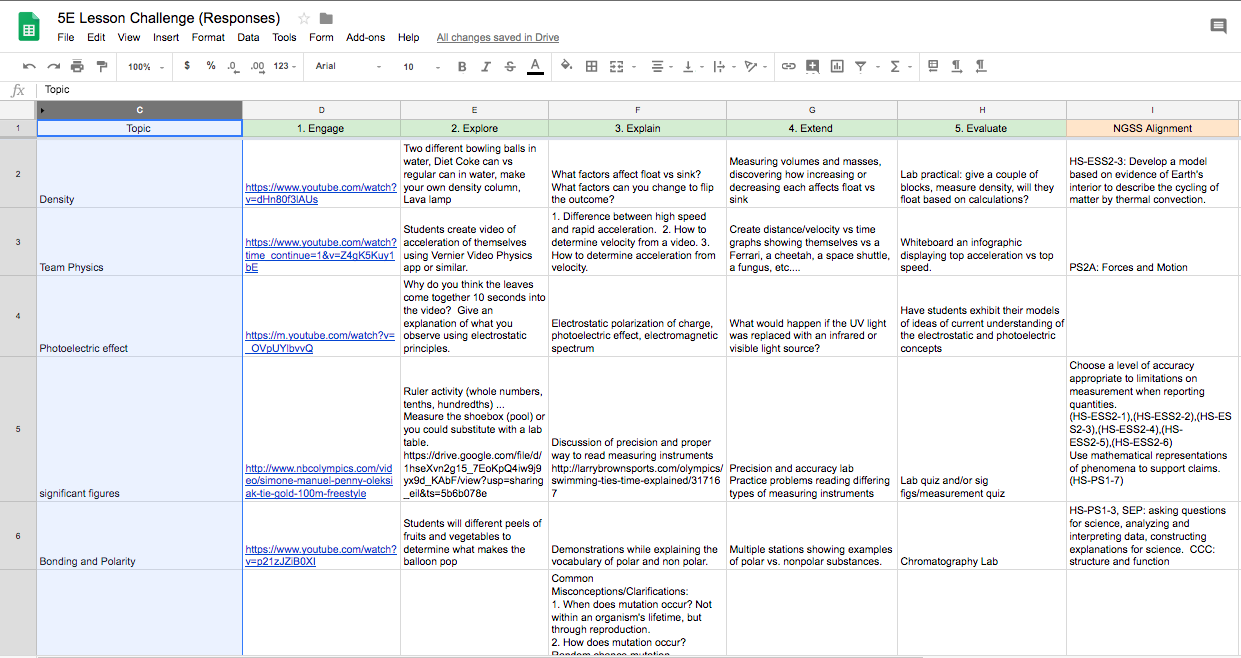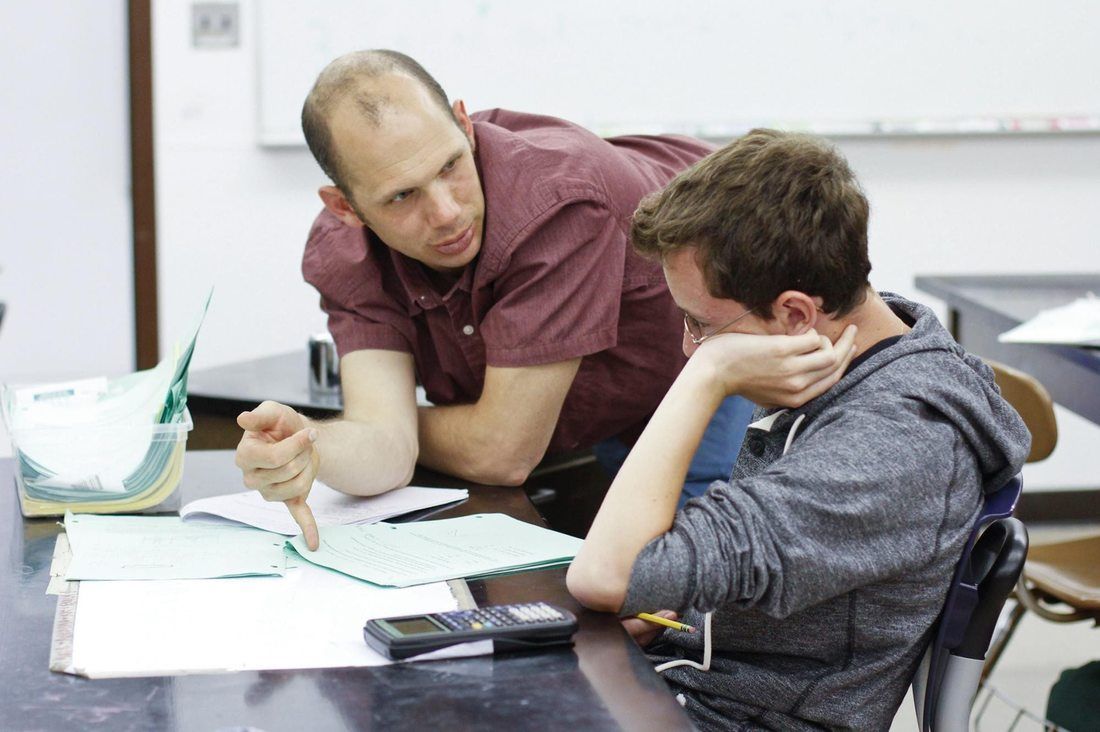|
|
|
My top three strategies, ideas, or tools of the week!
A few weeks ago I had the pleasure of working with the science educators at D211 in Chicago's Northwest Suburbs. As part of the workshop, all teachers were challenged to work in discipline specific teams to create an outline for an NGSS aligned, 5E Learning cycle. They were too good not to share! Click on the image below to access all lesson outlines. Enjoy!
In past years I always had students create either a blog or a website to publicly share their work and curate their progress. Click here for an example.
While I believe deeply in students archiving their work in a public space, after reading Show Your Work, an outstanding book by Austin Kleon, I began to put an incredible amount of pressure on myself to empower students to create beautiful space to showcase their work. In short, I lost track of the pedagogy, in replace for aesthetics. It's not Austin's fault. It's mine. Please read his book, it's hecka inspiring. I reflected on the lack of improved student metacognition despite my enhanced portfolio systems, and student comments such as "Do we have to do another portfolio post. I never look at it...". I began to ask myself: What really actually works? (in my classroom, with MY students). I remembered another comment from one student specifically: "Can we just put everything we did in this topic in a Google Slide presentation. It's SO much easier to include pictures and videos...". My initial reaction to this statement was one of hesitation. No way! Kleon calls us to share our work in a space we are proud of. Nobody is going to look at your Google Slides! Your work needs be in a beautiful website to be taken seriously! Again, aesthetics before pedagogy. Not a good choice. This year, I am putting down my tired attempts at doing what I think is the most "innovative" approach, and following my gut regarding what I feel and my students feel is the most impactful! I am taking my students advice. I created a Google Slide template for each unit, including spaces for students to link all of their major work (Labs, Case Studies, etc.) and a template for built in student reflection. Click here to access the Google Slide portfolio template, and click here to access our class website which will house "view only" version os the portfolios. Yes, not as beautiful as Weebly, SquareSpace, WIX, or even the NEW Google Sites. Ironically however, in just two days of class, I am already noticing a shift in student focus on the project at hand, and not where or how they report it. And...in the end...nothing is stopping us from embedding their Google Slides in a beautiful website. Wink.
I have written many times before about the connection between the 5E learning cycle and Joseph Campbell's Hero's Journey. Click here for a diagram that pairs the two processes together well.
Perhaps the most important part of the shifting one's instruction to an inquiry learning cycle approach is challenge of "Calling Students to Adventure", engaging them by strategically sparking their curiosity. The goal of this process is to STRATEGICALLY elicit spontaneous questioning about a topic in such a way that students begin to ask question about the lesson plan you have already created. Yes, you could ask them the questions directly. However, I find when the questions come directly from the students they are markedly more engaged and empowered. Below is an example of a "spark" I recently found that I plan to use in my chemistry class during the 2018-2019 school year: Electrochemistry, specifically the intricacies of oxidation and reduction tend to be challenging ones to engage students in. The process of electron flow can be a challenging one to visualize, and beyond making batteries with lemons, nails and pennies, finding a simple, tangible, and engaging way to created a window into the topic and spark spontaneous, natural intrigue about the topic is something I have yet to do successfully. Keeping this in mind, this summer I spotted one of my 5th grade science camp students dropping a AA battery and watching it bounce. When I confronted him he said: "If it bounces it's empty. If it doesn't it's full". At the time wasn't yet aware that this "bounce test" was a viral internet phenomenon. After sitting there watching this young camper test battery after battery I found myself asking questions: "Why does it bounce?" "Why does it not bounce?" "Is this real?" "Is this a hoax?" After contemplating the process, and scribbling the inner workings of an electrochemical cell on the adjacent whiteboard in search of a personal explanation, I finally resorted to the internet and found a few articles on the topic. This article was the most comprehensive and successfully quenched my curiosity. I also found this video on the topic, which gave me an idea of a potential student activity on the topic. After spending a few hours reviewing all of the videos on the topic, I decided to create my own battery bounce test curiosity spark on the a few day ago. A simple video that gets to the heart of the issue, and makes the information gap as salient and as clear as possible with the goal of tunneling students into the same questions I asked above. Click here to see the video or view below: Essentially I had gone on my own Hero's Journey..Embodied my own 5E Learning cycle..Lived the metaphor that I speak of so much when working with other teachers or writing blog posts (like this one!). The young 5th grade science camper ENGAGED me with his battery bounce test. The subsequent information gap forced me to EXPLORE reasons for this by accessing my prior knowledge. My lack of ability to resolve this perplexity led to a need for a mentor (the internet) to help me EXPLAIN the concept. I am now EXTENDING this concept, converting it into a lesson plan for the upcoming school year, and will EVALUATE the lessons efficacy when done.
If you found the information in this message useful to your practice, I invite you to learn more about becoming a site member. Monthly membership includes, but is not limited to, frequent distributions of detailed online video courses, lesson plans, teaching websites, curricular resources, and access to webinars exploring the world of curiosity, inquiry, and technology in the classroom. Additionally, you can find a copy of my new book, "Spark Learning: 3 Keys to Embracing the Power of Student Curiosity", by clicking here.
My top three strategies, ideas, or tools of the week!
If you found the information in this message useful to your practice, I invite you to learn more about becoming a site member. Monthly membership includes, but is not limited to, frequent distributions of detailed online video courses, lesson plans, teaching websites, curricular resources, and access to webinars exploring the world of curiosity, inquiry, and technology in the classroom. Additionally, you can find a copy of my new book, "Spark Learning: 3 Keys to Embracing the Power of Student Curiosity", by clicking here.
|
Categories
All
Archives
March 2024
|


 RSS Feed
RSS Feed